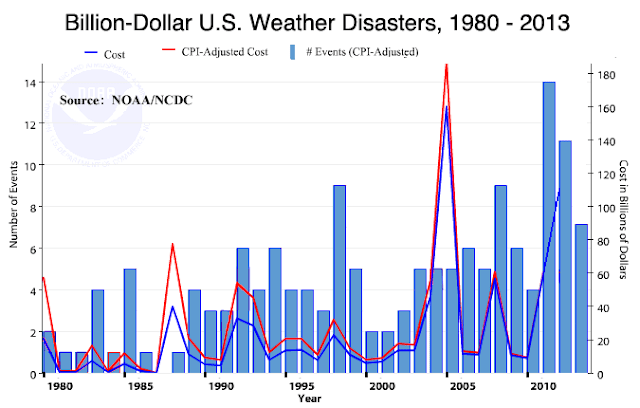The Credulous Bunny Takes a Look
One thing that Eli, credulous bunny, should have learned, is that when you read something by PRJr, well you count your fingers afterwards. So Roger wrote
and Eli commented. In the midst of this Kevin quoted from the Stern Review Executive SummaryStern Review (on clim chg) came out 10 yrs ago— Roger Pielke Jr. (@RogerPielkeJr) October 24, 2016
Predicted weather disasters wld be >0.6% GDP in 2016 https://t.co/jN0v6AofsO
Only off by 400% pic.twitter.com/PiPHW54zAl
The increased costs of damage from extreme weather (storms, hurricanes, typhoons, floods, droughts, and heat waves) counteract some early benefits of climate change and will increase rapidly at higher temperatures. Based on simple extrapolations, costs of extreme weather alone could reach 0.5 - 1% of world GDP per annum by the middle of the century, and will keep rising if the world continues to warm.but of course there is more, for example in the text from Page 10 Chapter 5
The costs of extreme weather events, such as storms, floods, droughts, and heatwaves, will increase rapidly at higher temperatures, potentially countering some of the early benefits of climate change. Costs of extreme weather alone could reach 0.5 - 1% of world GDP by the middle of the century, and will keep rising as the world continues to warm.
The consequences of climate change in the developed world are likely to be felt earliest and most strongly through changes in extreme events - storms, floods, droughts, and heatwaves. This could lead to significant infrastructure damage and faster capital depreciation, as capital-intensive infrastructure has to be replaced, or strengthened, before the end of its expected life. Increases in extreme events will be particularly costly for developed economies, which invest a considerable amount in fixed capital each year (20% of GDP or $5.5 trillion invested in gross fixed capital today). Just over one-quarter of this investment typically goes into construction ($1.5 trillion - mostly for infrastructure and buildings; more detail in Chapter 19). The long-run production losses from extreme weather could significantly amplify the immediate damage costs, particularly when there are constraints to financing reconstruction.
The costs of extreme weather events are already high and rising, with annual losses of around $60 billion since the 1990s (0.2% of World GDP), and record costs of $200 billion in 2005 (more than 0.5% of World GDP). New analysis based on insurance industry data has shown that weather-related catastrophe losses have increased by 2% each year since the 1970s over and above changes in wealth, inflation and population growth/movement. If this trend continued or intensified with rising global temperatures, losses from extreme weather could reach 0.5 - 1% of world GDP by the middle of the century.27 If temperatures continued to rise over the second half of the century, costs could reach several percent of GDP each year, particularly because the damages increase disproportionately at higher temperatures (convexity in damage function; Chapter 3).The auditors are interested












